Category:Chemistry Experiments’
Winter Science: Mouthwatering Maple Syrup Snow Candy
- by KitchenPantryScientist
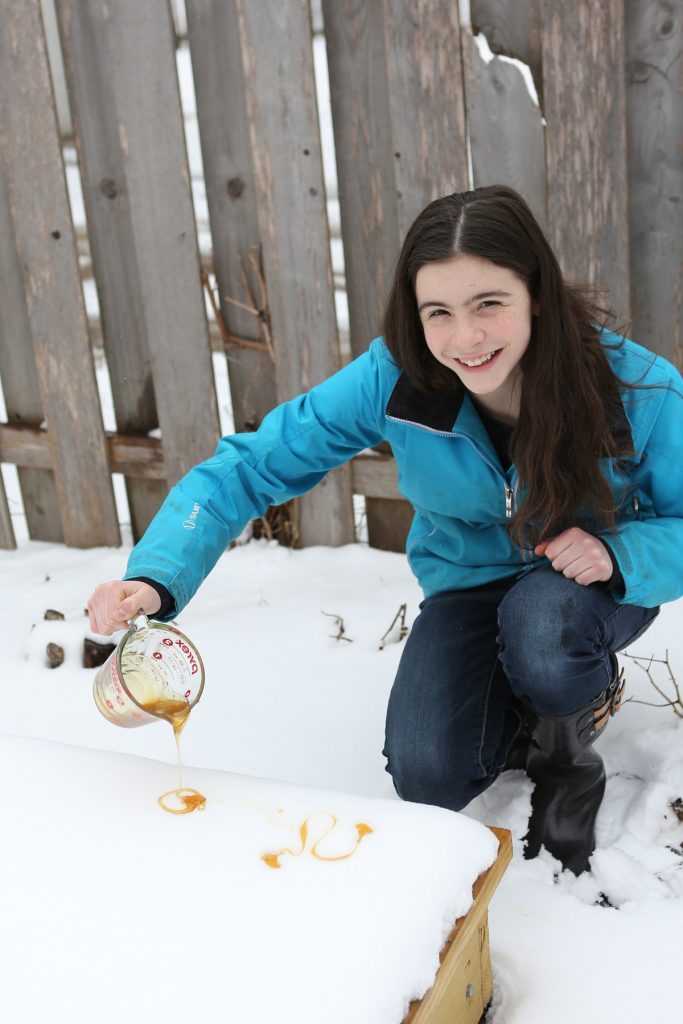
Maple Snow Candy from Outdoor Science Lab for Kids (Quarry Books 2016)
Remember this homemade snow candy from Laura Ingalls Wilder’s classic “Little House in the Big Woods?” You can make the same amazing maple treats using heat evaporation and quick cooling in the snow, or on crushed ice cubes.
Here’s how to make the candy, along with some candy-making science, straight from the pages of my new book, “Outdoor Science Lab for Kids,” which you can order from your favorite book retailer by clicking here.
You’ll need:
-1 cup pure maple syrup
-sauce pan
-candy thermometer
-fresh, clean snow
Safety Tips and Hints:
-Hot sugar syrup can cause burns. This experiment must be done with adult supervision.
-Allow candy to cool completely before tasting.
-Only use pure maple syrup for the best results.
Directions:
Step 1: Go outside and scout out a spot with some clean snow several inches deep for making your candy. Alternately, collect and pack down a few inches of fresh snow in a large, flat container, like a casserole dish. (You can use crushed ice cubes if you don’t have snow.)
Step 2. Boil the maple syrup in saucepan, stirring constantly until it reaches around 235-240 degrees F (soft ball stage.)
Step 3. Remove the maple syrup from the heat and carefully pour it into a heat-resistant container with a spout, like a Pyrex measuring cup.
Step 4. Pour wiggly candy lines into the snow to freeze them into shape.
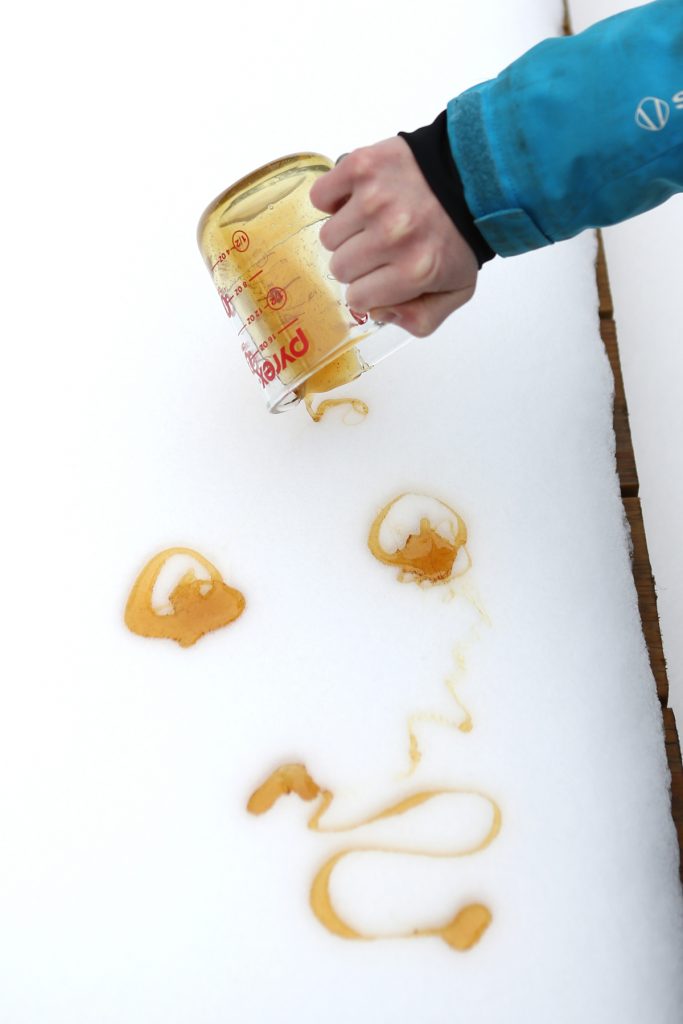
Maple Snow Candy from Outdoor Science Lab for Kids (Quarry Books 2016)
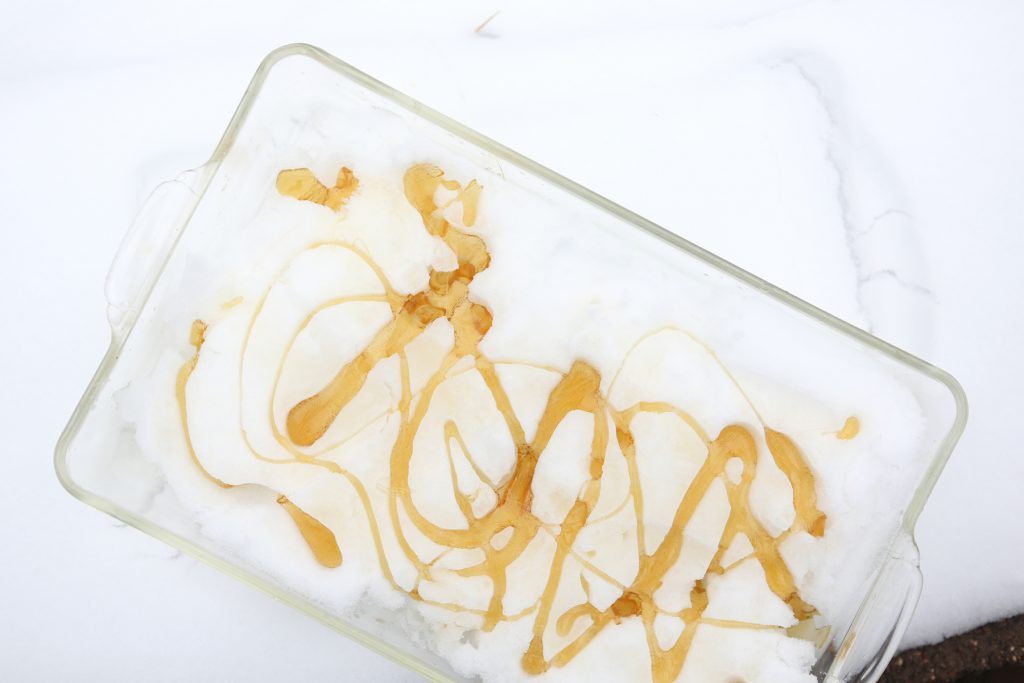
Alternately, make snow candy in a casserole dish filled with fresh snow or crushed ice.
Step 5. When you’re done, remove the candy from the snow with a fork.
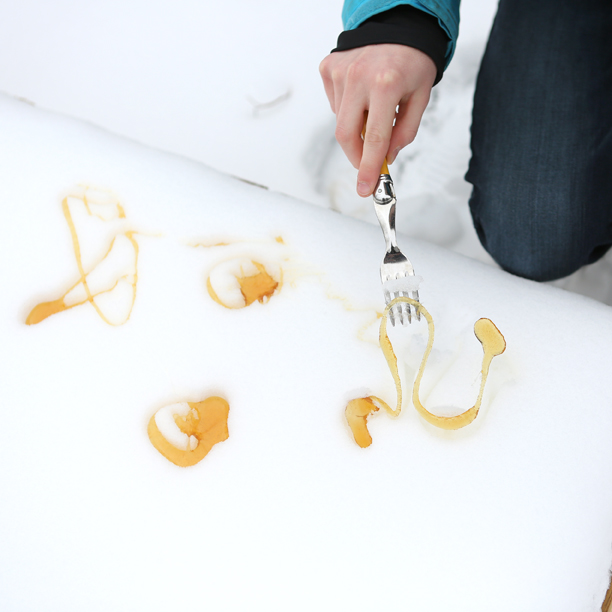
Maple Syrup Snow Candy from “Outdoor Science Lab for Kids” (Quarry Books 2016)
Step 6. Eat your candy right away, or let it warm up and wind it around sticks or skewers to make maple lollipops. Enjoy!
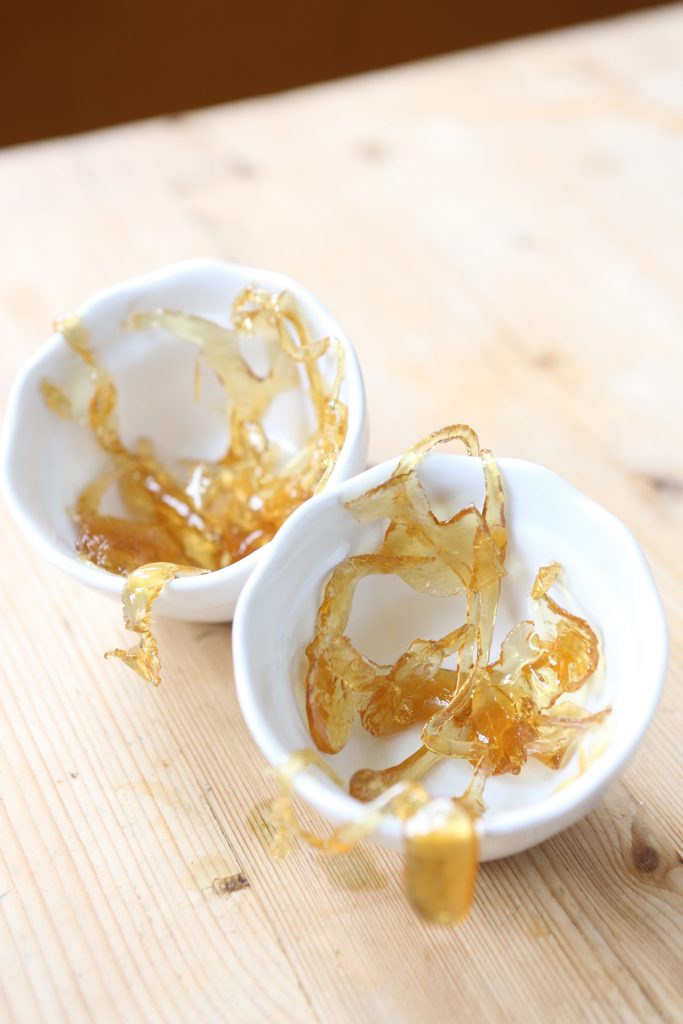
Maple Snow Candy from Outdoor Science Lab for Kids (Quarry Books 2016)
The Science Behind the Fun:
Maple syrup is made from watery tree sap boiled to evaporate most of the moisture it contains when it’s first tapped from a tree. Following evaporation, the syrup that remains is mostly made up of a sugar called sucrose, but it also contains smaller amounts of glucose and fructose.
Naturally, other organic compounds are also present in tree sap, giving syrup from different areas unique flavors. Syrup collected earlier in spring when it is cold tend to be light in color and have a mild flavor. As the days get warmer, microbes ferment some of the sugar in the syrup, making it darker and giving it a more robust taste.
In this experiment, you heat maple syrup, evaporating even more water. A super saturated solution forms, which holds more sugar molecules in the liquid than would be possible if you evaporated the water at room temperature.
When you pour the supersaturated sugar into the snow, it cools quickly, forming some sugar crystals to give the maple candy a soft, semi-solid consistency. Heating the syrup to a higher temperature will evaporate more water, resulting in even more crystal formation in the cooled syrup, making it harder to bite. If you carefully evaporate all of the water from maple syrup, you’ll be left with pure maple sugar crystals.
Creative Enrichment:
-Try collecting some syrup from your pan at several different temperatures and compare the resulting snow candy for texture, color and consistency.
-Can you do the same experiment with other sugar syrups, like molasses or corn syrup?
-Try to make maple sugar.
Slime Kit: Homemade Science-y Holiday Gifts for Kids
- by KitchenPantryScientist
Buying gifts is fine, but it’s more fun to make them. This year, we decided to make botanical gifts for the adults on our list, and slime kits for the kids.
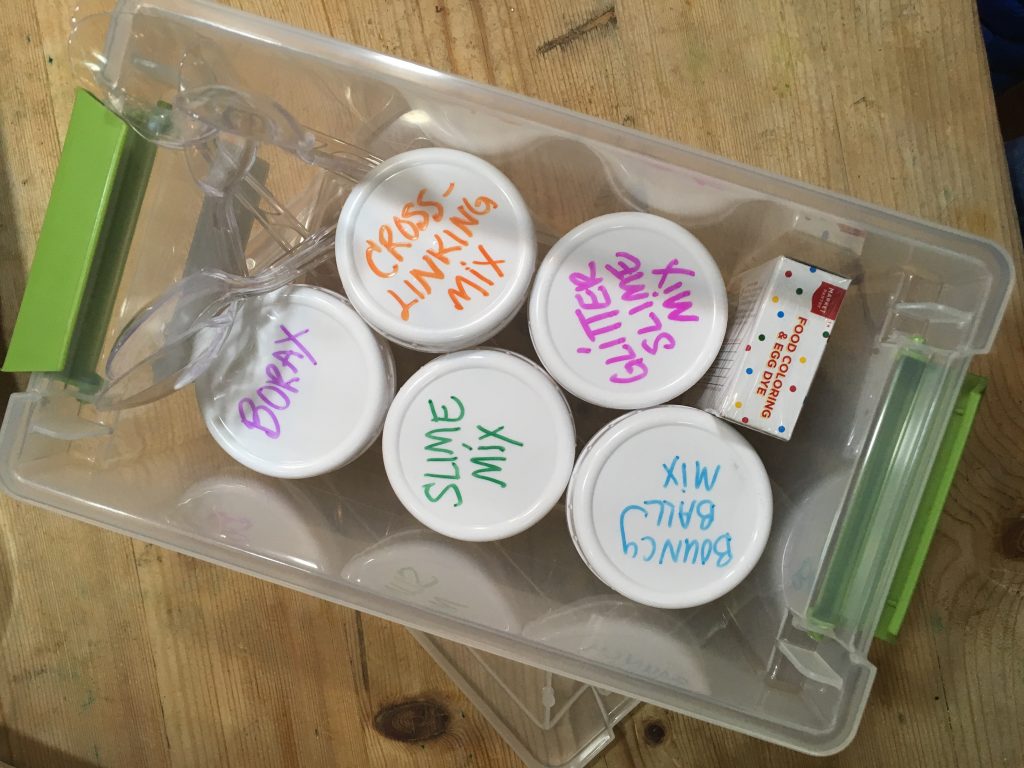
To make a slime kit, you’ll need:
-glue
-glitter glue (optional)
-Borax laundry detergent
-small plastic sample cups or paper cups (optional)
-food coloring
-jars with lids
-a small plastic bin or shoe box
-plastic spoons
-extra glitter (optional)
Label the jars and fill as follows:
- Bouncy Ball Mix (fill with glue)
- Slime Mix (fill with equal parts glue and water, mixed well)
- Borax detergent (fill with powdered detergent)
- Cross-Linking Solution (leave empty)
- optional-Sparkly Bouncy Ball mix (fill with glitter glue)
- optional-Sparkly Slime Mix (fill with equal parts water and glitter glue, mixed well)
Make an instruction sheet for the kit. (Print out the info below, or copy it onto a card.)
To make slime:
- Fill Cross-Linking Solution container with warm water. Add about 2 tsp Borax per 1/2 cup water to the container. Mix well. (Don’t worry if all the Borax doesn’t dissolve!)
- Add a few spoonfuls of Ball Mix or Slime Mix to a small plastic cup or paper cup.
- Add a drop or two of food coloring to the cup. Stir.
- Add 3 spoonfuls of the Cross-Linking Solution to your ball mix or slime mix and stir well.
- If the slime still feels too sticky, add a little more Cross-Linking Solution.
- Remove your completed slime from the cup.
The Science Behind the Fun:
Glue is a polymer, which is a long chain of molecules linked together, like a chemical chain. The polymer formed by water and glue is called polyvinyl acetate.
The Borax solution is called a cross-linking substance, and it makes the glue polymer chains stick to each other. Eventually, all the chains are bound together and no more cross-linking solution can be taken up.
To finish the slime kit, fill the plastic bin with the ingredients you put together, including jars of ingredients, instructions, plastic spoons, and mixing cups (optional.)
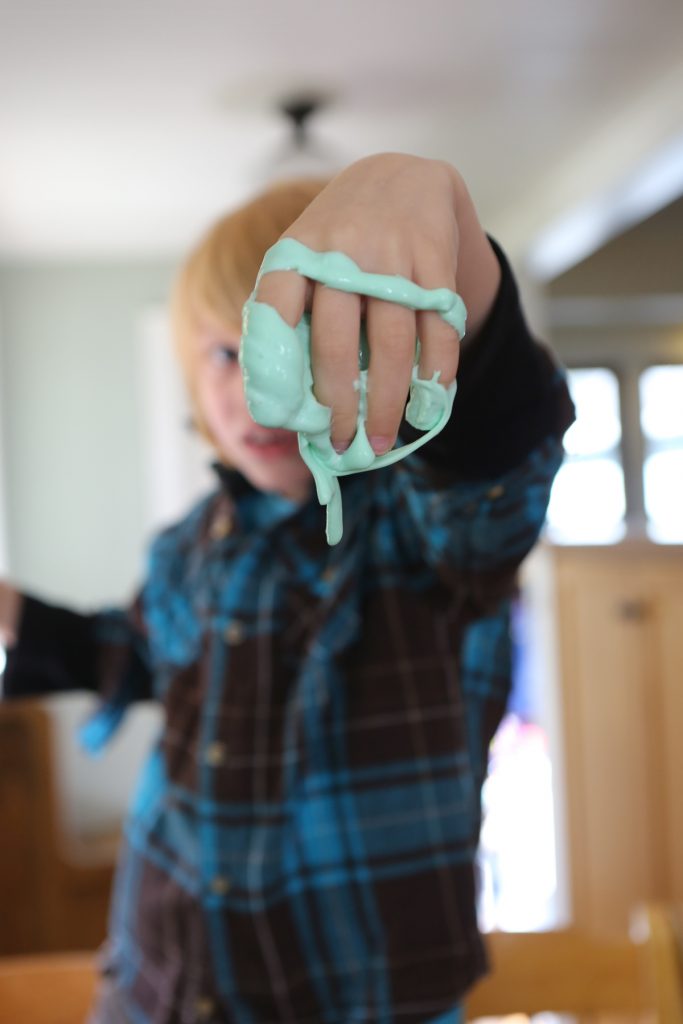
Slime from Kitchen Science Lab for Kids (Quarry Books)
Candy Experiments
- by KitchenPantryScientist
We have bags full of candy at our house, and I’d like to see them disappear as quickly as possible. Here are a few science experiments we tried, substituting candy for other ingredients:
Candy Chromatography: We put candy in water and used coffee filters to separate out the colors, via capillary action.
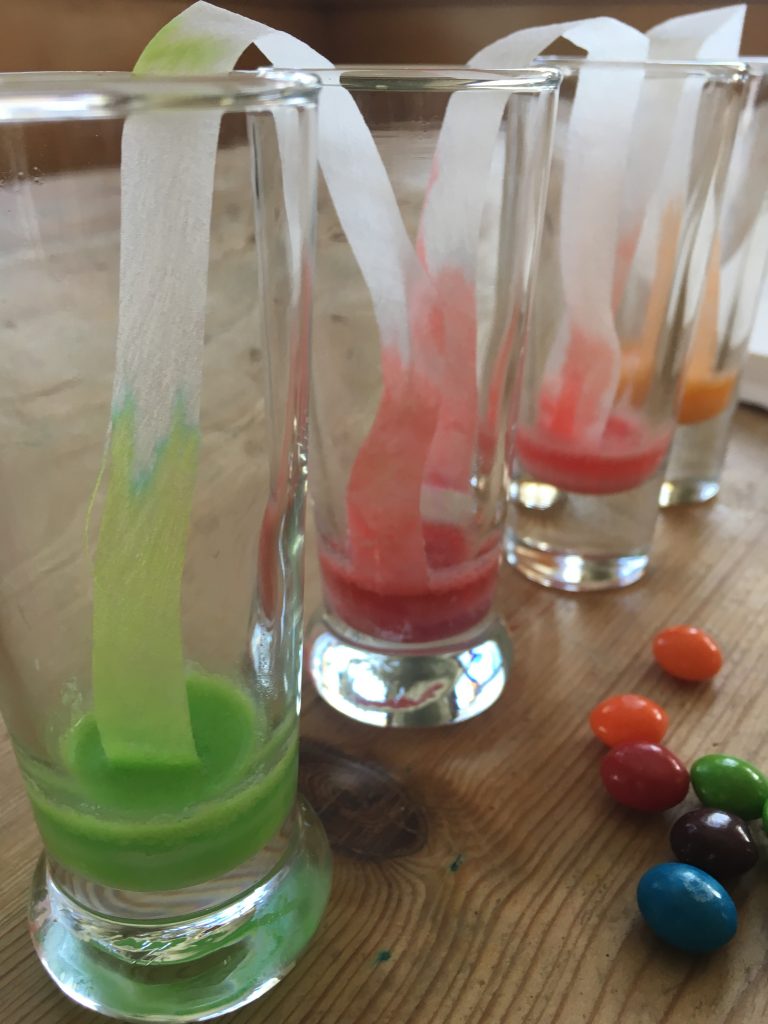
Skittles in water with coffee filter strips between cups…
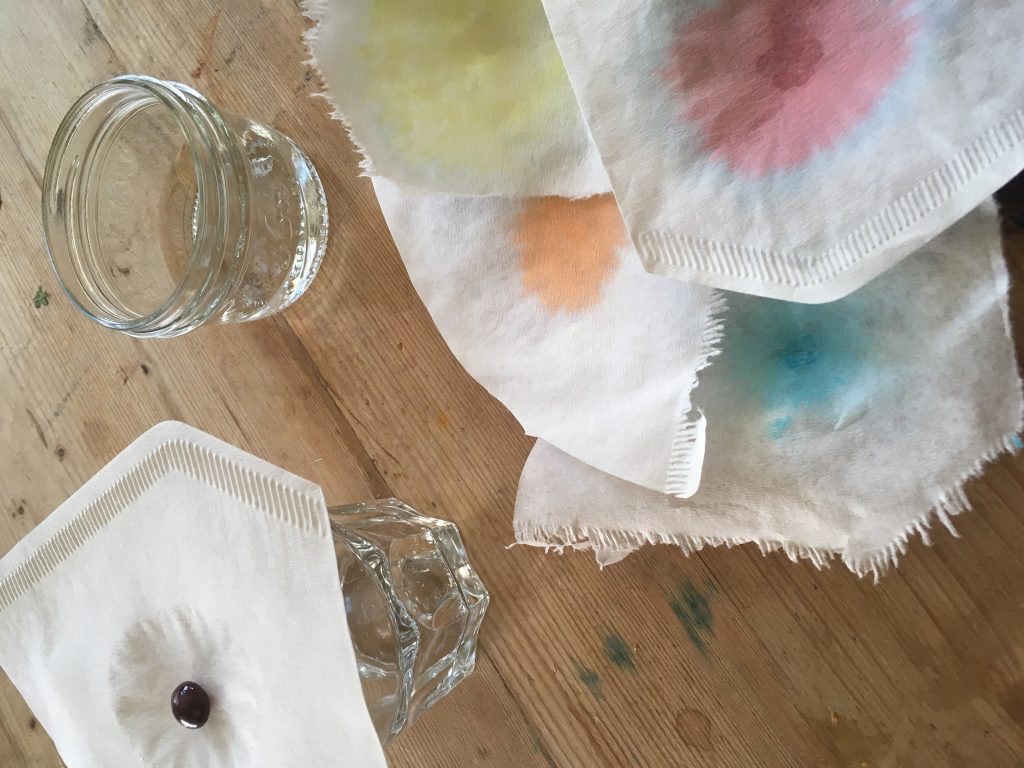
Coffee filters on cups, with water dripped onto a piece of candy.
Candy-drinking plants? We dissolved candy in warm water and added white carnations with cut/split stems to see whether they’d change color as the flowers drew the water up into their petals.
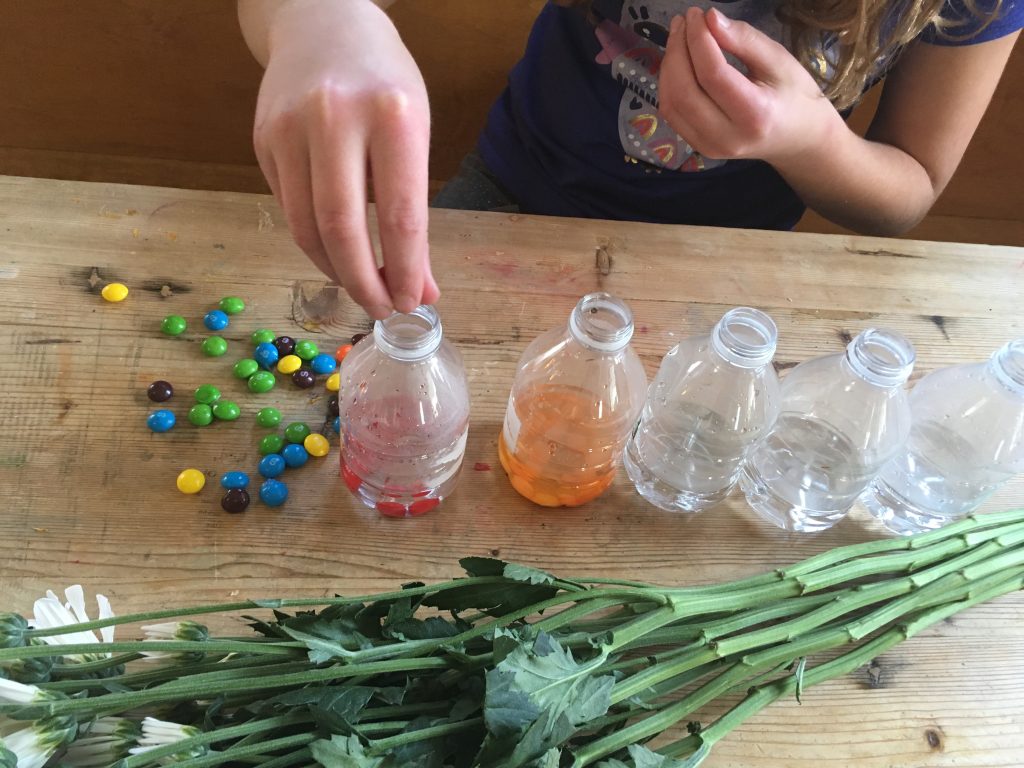
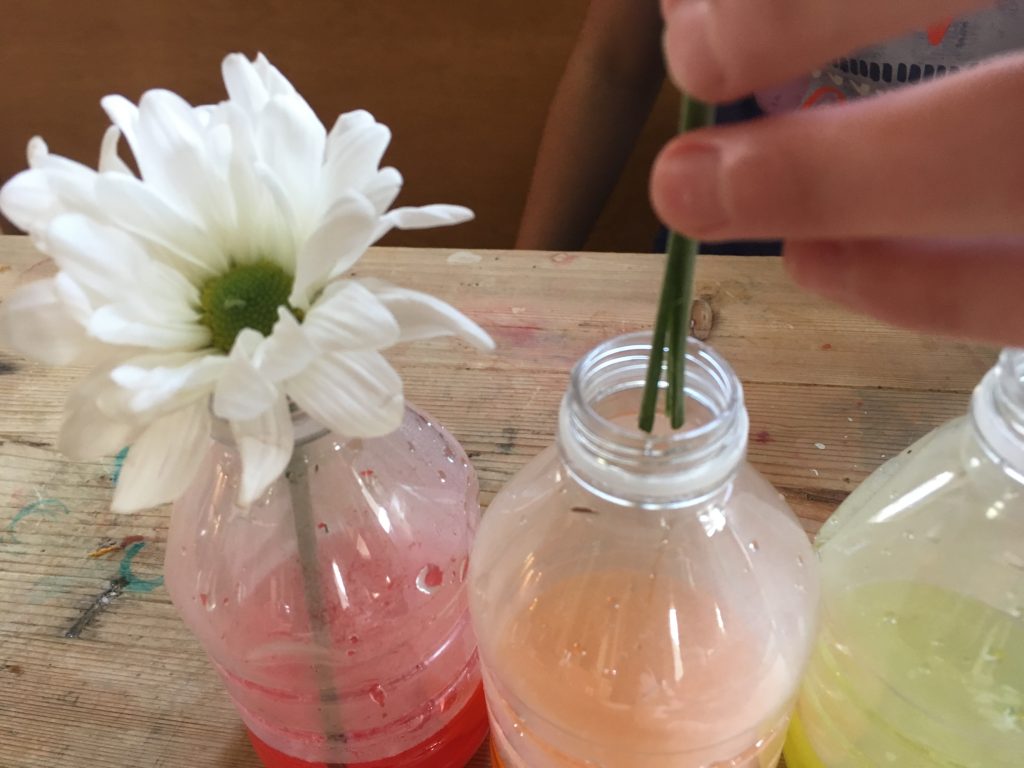
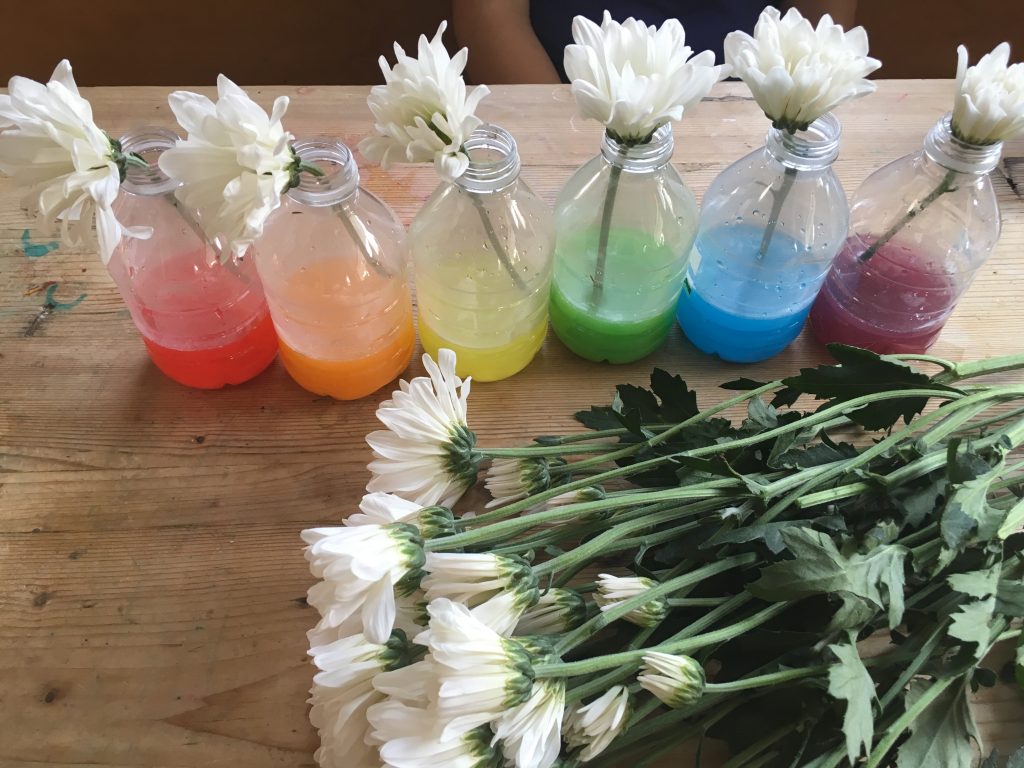
Candy Vegetable Vampires: We tried the same experiment with Napa Cabbage, via the Vampire Vegetables experiment in Kitchen Science Lab for Kids.
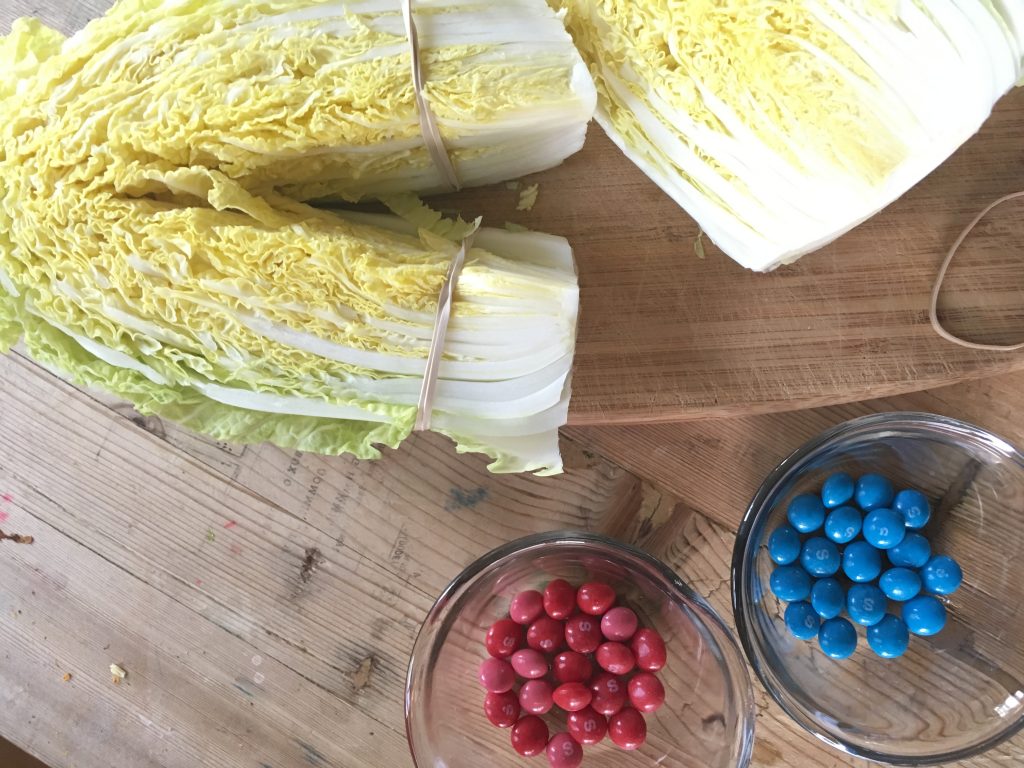
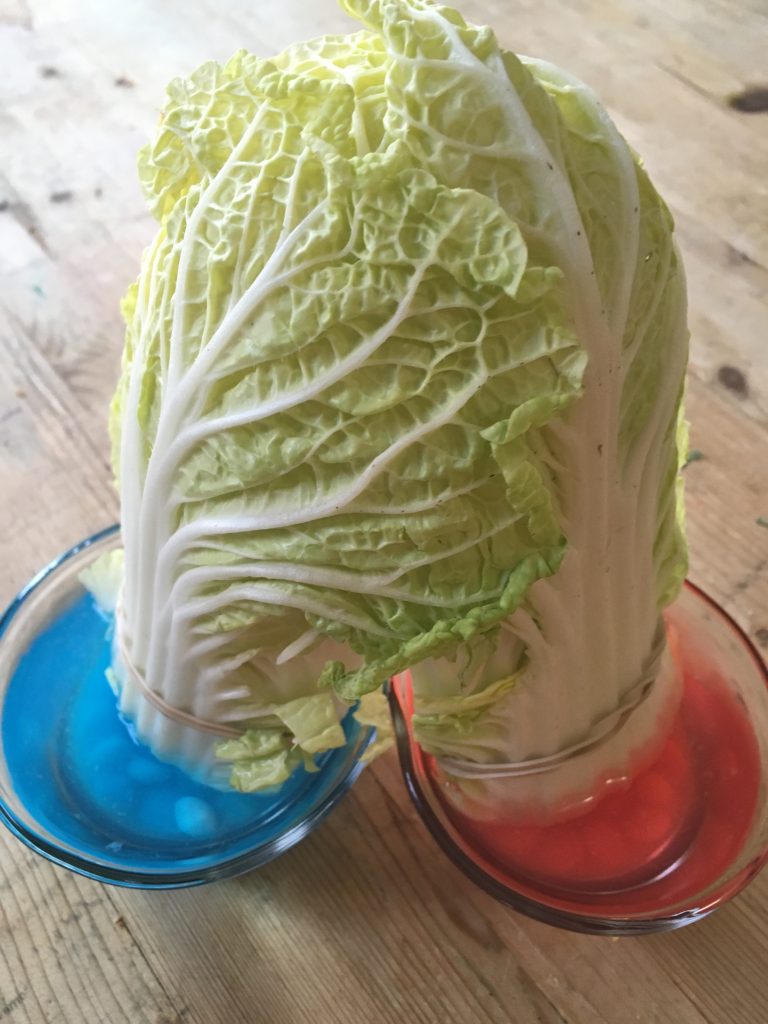
We’re also going to freeze candy in ice and make Tie Dye milk with Skittles!
What could you try with your candy?
10 Fun Kitchen Halloween Science Experiments for Kids
- by KitchenPantryScientist
Here are ten quick and easy experiments to make your Halloween even more fun and memorable!
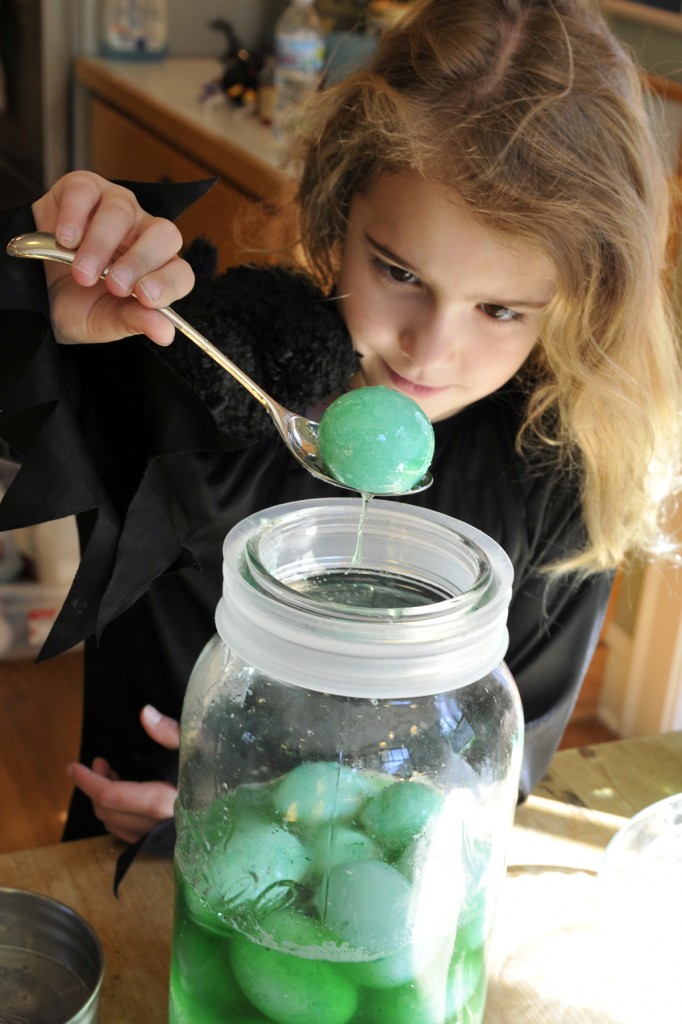
Click on these links for instructions on how to make:
Oozing Monster Heads (from Outdoor Science Lab for Kids)
Frankenworms (from Kitchen Science Lab for Kids)
Cornstarch Goo (from Kitchen Science Lab for Kids)
Mad Scientist’s Green Slime (from Kitchen Science Lab for Kids)
Alien Monster Eggs (from Kitchen Science Lab for Kids)
Magic Potion (from Kitchen Science Lab for Kids)
Bags of Blood (from Kitchen Science Lab for Kids)
Vegetable Vampires (Scholastic.com/Experiment from Kitchen Science Lab for Kids)
Here are a few of my favorites!
You can find more experiments by scrolling down on my website!
Dry Ice Science
- by KitchenPantryScientist
We had a great time playing with dry ice on WCCO TV this morning. I showed viewers how to make spooky Halloween decorations (hot water, food coloring and dry ice), carbonate beverages, inflate a balloon, and even make a spoon “sing.”
Dry ice is literally really cool, which is why you have to wear gloves to handle it. It’s made from frozen carbon dioxide gas, and as it warms up, it goes from the solid to liquid state instantly, skipping being a liquid altogether in a process called sublimation. As it becomes a gas, it cools water molecules in the air around it, making fog. And if you add it to a liquid, it carbonates the liquid with bubbles.
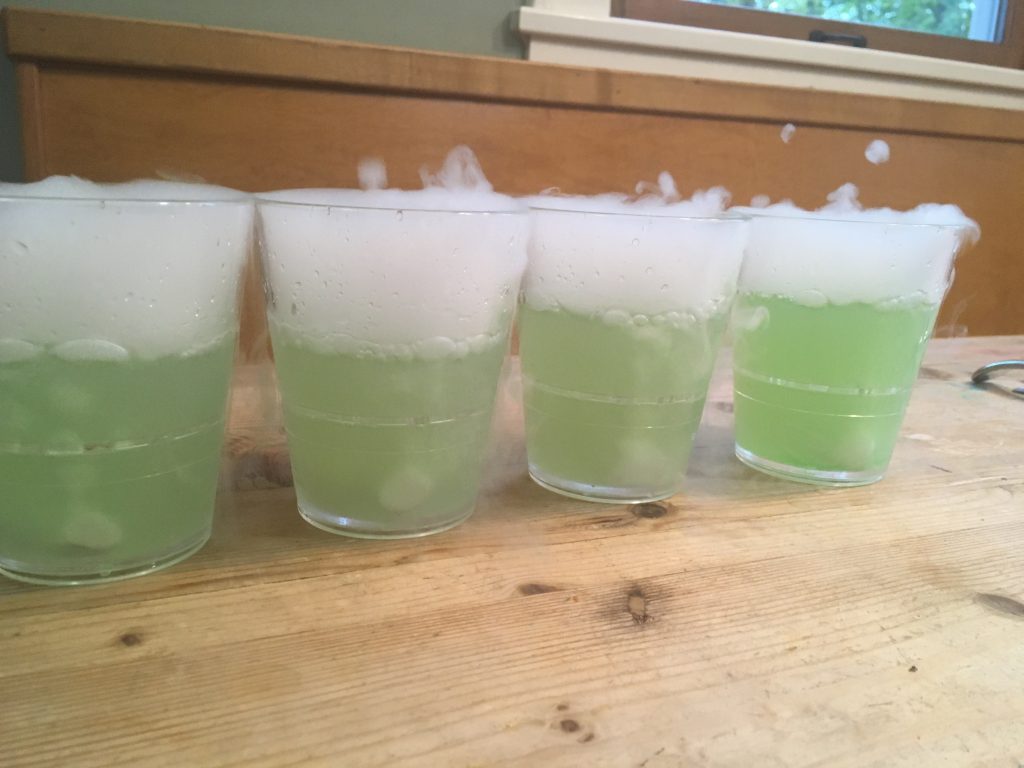
To make dry ice, you have to get carbon dioxide gas really cold and put it under pressure so that it goes instantly from the gas phase to the solid phase in a process called deposition. Here’s a video of a machine that makes dry ice pellets:
Foaming Alien Blood
- by KitchenPantryScientist
If you’ve ever seen the X-Files, you know that foaming green alien blood is pretty scary.
It’s simple to use kitchen table chemistry to mix up your own batch of green alien blood with corn syrup, green food coloring, water and baking soda.
Just add vinegar (tell your friends it’s water) to make it foam.
Mix together:
2 Tbs corn syrup
1 tsp baking soda
green food coloring
1/2 tsp water
When you want to make your slime foam, add a few tsp of vinegar.
You could make the same thing with red food coloring and call it vampire blood!
The Science Behind the Fun: When you add baking soda (sodium bicarbonate) to vinegar (acetic acid), there’s a chemical reaction that creates carbon dioxide gas bubbles!
Experiment created by Liz Heinecke at KitchenPantryScientist.com
Halloween Science: Non-Toxic Fake Blood
- by KitchenPantryScientist
Unlike the foaming green alien blood in the X-Files, the blood pulsing through our veins is red, thanks to iron-containing hemoglobin molecules loaded with life-giving oxygen.

fake blood
To make fake blood that looks like real blood, you’ll need to concoct a mixture of liquid, thickeners and red pigment (tinted with blue and brown.) Kids will have a great time coming up with their own concoctions. Have a creative chemistry contest to see who can come up with the most realistic fake blood, or use it to make scary Halloween props.

Here’s a recipe to start with, but kids can work with smaller amounts and mix their blood in bowls, rather than a blender. Fake blood stains everything it touches, so be prepared for messy hands and wear old clothes! Naturally red plant pigments, like the ones in pomegranate juice and raspberry jam won’t stain fingers as much as food coloring and taste yummy. However, red food coloring will give you a more realistic color.
Blend together:
1/3 cup pomegranate juice (like POM) or fruit punch
2 Tbs corn starch
1 Tbs chocolate syrup (or 1 Tbs cocoa powder)
1 Tbs red food coloring
1 cup corn syrup
Tint with a tiny bit of blue food coloring. (optional)
Other ingredients to try: seedless raspberry jam, cocoa powder, Kool-Aid, Jell-O, flour, maple syrup
Here’s a fun TV segment where meteorologist Matt Brinkman was game enough to try out one of the blood capsules we made!
We made the edible blood capsules you see in the video by filling empty gelatin and vegetarian capsules with a mix of raspberry jelly, corn syrup and chocolate syrup.
Marbling Science
- by KitchenPantryScientist
I’ve always wanted to try paper marbling and knew there must be some science involved. So, we gave it a go, and the results were stunning!
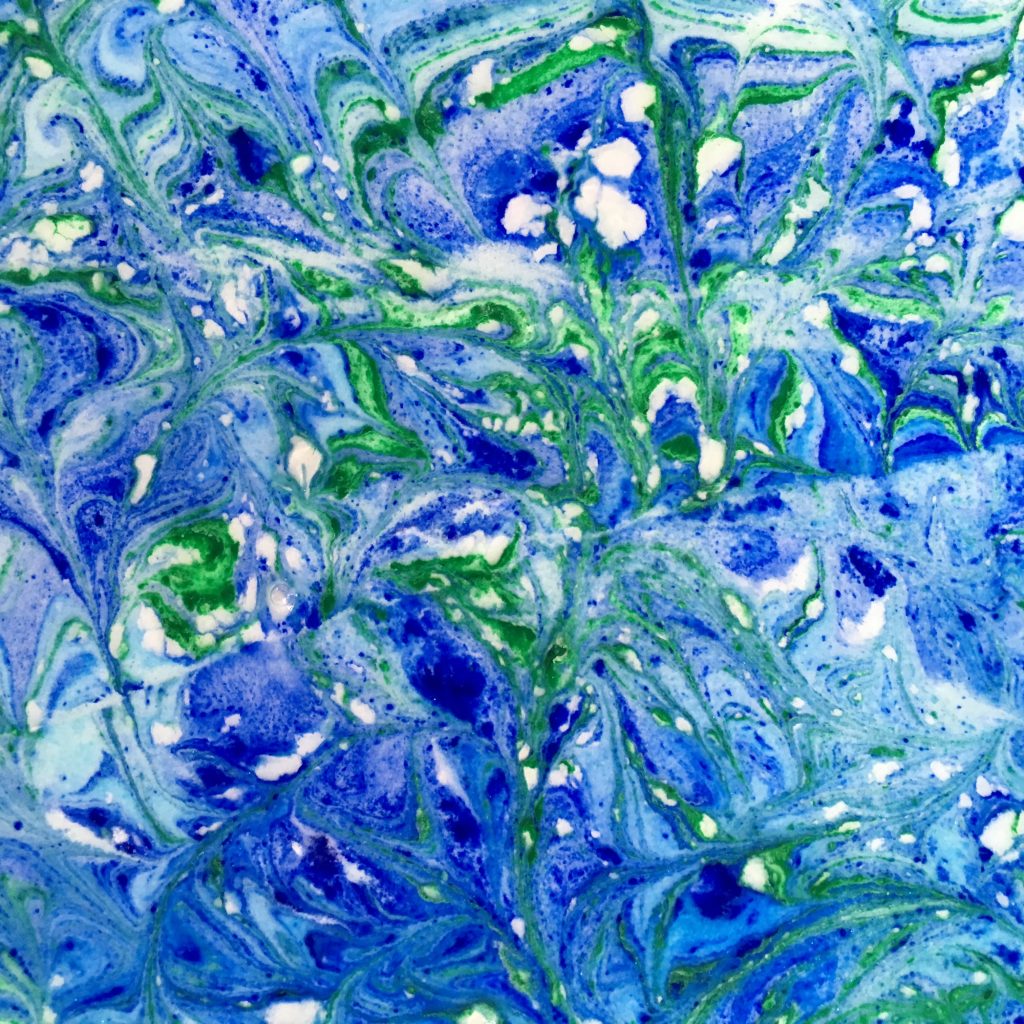
tempera paint marbling- photo by kitchenpantryscientist.com
![IMG_1586[1]](https://kitchenpantryscientist.com/wp-content/uploads/2016/09/IMG_15861-1024x768.jpg)
paper marbled with the Innovation marbling kit (Boku-Undo Suminagashi) from DickBlick.com – photo by kitchenpantryscientist.com
We tried two methods: one with liquid starch (made from cornstarch) and tempera paint, and another with a marbling kit. Both worked well, but look very different.
The Science Behind the Fun: Water molecules like to stick together, a property which scientists call surface tension. This property allows very thin layers of ink to float on water, mixing in beautiful patterns when you break the surface tension with detergent, a tool like a paintbrush, or movement. To marble paper, you have to use dye or paint that floats on the water where it can be easily transferred to paper. Alternately, you can make the liquid underneath more dense than the dye or paint, to help the dye float.
When transferring the ink or paint designs, it helps to use paper that’s been coated with a chemical called a mordant, that combines with substances (usually dyes) to make large molecules that stay in one place. (Iodine is another mordant, which is used to stain bacteria.)
Here’s a video of my 10YO making designs using the pre-made marbling kit…(More info at the bottom of this post.)
Since I like to do experiments using non-toxic, inexpensive ingredients most people have on hand, we first tried a method that uses cornstarch to thicken the bottom liquid layer and tempera paint as the dye. It requires pre-treatment of paper, like inexpensive watercolor paper from Target, with the mordant aluminum sulfate (alum), which you can find at your local coop or grocery store.
You’ll need:
-watercolor paper (cheap stuff from Target works just fine)
-two large, flat trays, like 9×13 pans
-2 tps. Alum (aluminum sulfate crystals)
-a sponge brush
-2 Tbs. corn starch
-eye dropper
-tempura paint (the more colors, the merrier)
-newspaper
- Dissolve 2 tsp alum in 3/4 cup water. Avoid inhaling powder.
- Mark one side of your watercolor paper with an A and use a sponge brush to apply alum solution evenly to that side of the paper.
![IMG_1480[1]](https://kitchenpantryscientist.com/wp-content/uploads/2016/09/IMG_14801-e1473219315556-768x1024.jpg)
- Let the paper dry overnight, or speed drying with a blow dryer.
- Make a double recipe of liquid starch by dissolving 4 Tbs. corn starch in 1/2 cup cold water. Bring 6 cups water to a boil in a sauce pan. Add the cornstarch solution to the water, stir well and boil for 1 minute. Turn the heat to low and simmer for 2 more minutes, stirring occasionally.
- Pour 3 cups of the hot liquid starch into one 9×13 pan and let cool.
- Pour 3 cups of cold water into the other pan.
- Prepare paint by mixing tempura paint with water until it has the consistency of half-and-half or whole milk.
- When starch is cool, drip paint onto the surface of the starch using an eyedropper, or something similar. Rinse dropper between colors.
![IMG_1503[1]](https://kitchenpantryscientist.com/wp-content/uploads/2016/09/IMG_15031-1024x1024.jpg)
- Swirl paint, or use toothpicks to drag out patterns.
![IMG_1521[1]](https://kitchenpantryscientist.com/wp-content/uploads/2016/09/IMG_15211-1024x768.jpg)
- Carefully place your paper on the paint, alum side-down. Let it sit for a minute or two.
![IMG_1527[1]](https://kitchenpantryscientist.com/wp-content/uploads/2016/09/IMG_15271-e1473220884288-768x1024.jpg)
- Carefully peel the paper off of the paint and gently place it, face up, in the water pan.
![IMG_1532[1]](https://kitchenpantryscientist.com/wp-content/uploads/2016/09/IMG_15321-1024x768.jpg) Let it sink and move it back an forth gently to rinse off excess paint.
Let it sink and move it back an forth gently to rinse off excess paint. - Set the paper on a piece of newspaper to dry.
![IMG_1582[1]](https://kitchenpantryscientist.com/wp-content/uploads/2016/09/IMG_15821-e1473221209774-768x1024.jpg)
- Make more marble paper in the same paint pan. When you’re ready, repeat using the rest of the cornstarch.
The Innovation marbling kit (Boku-Undo Suminagashi) from DickBlick.com pictured below includes pre-made low density dyes that you drip onto a tiny floating disc of paper in a tray of water. It’s tons of fun and yields beautiful results. I got the kit at Blick art supplies, and used the paper they recommended, which may have been pre-treated with a mordant.
![IMG_1536[1]](https://kitchenpantryscientist.com/wp-content/uploads/2016/09/IMG_15361-e1473219139648-768x1024.jpg)
Have fun!
Homemade Pigmented Clay Paint
- by KitchenPantryScientist
I learned how to make this fun, clay-based paint at the Minnesota State Fair’s Eco Experience Progress Center. It’s colored with natural pigments(pigments are molecules that give things color) and doesn’t give off the same chemical fumes as some of the paints you might find in a hardware store. I love the earthy colors you can mix up with elemental pigments like iron oxide, zinc oxide and black iron oxide. It’s fun to mix up a little blue too, using Ultramarine Blue dried pigments.
![IMG_1362[1]](https://kitchenpantryscientist.com/wp-content/uploads/2016/08/IMG_13621-e1472689101230-768x1024.jpg)
To make this paint, you’ll need:
flour
cold water
hot water
EPK powdered clay (also called EPK Kaolin) -Can be ordered online. We got ours at continentalclay.com.
dried pigments, like the ones I mention above. -We got ours at dickblick.com
Safety tips: Check the warnings on dried pigments before you purchase them. Some are toxic and must be handled carefully. Avoid inhaling pigments.
To make your paint:
1. In a bowl, stir together 1/2 cup flour and 1/2 cup cold water. Mix well.
2. Add 1/4 cup hot water and mix well.
3. Add 1/4 cup EPK powdered clay and stir until smooth.
4. Continue adding flour and water until the paint has the consistency you want.
![IMG_1354[1]](https://kitchenpantryscientist.com/wp-content/uploads/2016/08/IMG_13541-1024x768.jpg)
5. Divide the paint into several containers and mix in pigment for color.
![IMG_1361[1]](https://kitchenpantryscientist.com/wp-content/uploads/2016/08/IMG_13611-1024x768.jpg)
6. Use paint on paper or canvas.
7. Paint may be stored in the refrigerator for a week or so.
Foaming Slime Volcano
- by KitchenPantryScientist
We supersized the foaming slime experiment from Outdoor Science Lab for Kids to make a giant foaming slime volcano. And it was awesome!